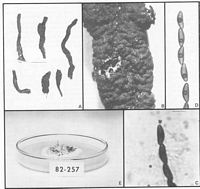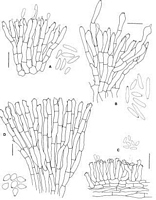|
 Xylaria berkeleyi Xylaria berkeleyi
BiostatusOccurrence uncertain
Images (click to enlarge)
Caption: Fig. 15 Xylaria cf. berkeleyi A, Stromata. B, Stromal surface. C, Ascal apex and ascospores
(Melzer's reagent). D, Ascospores (Melzer's reagent). E, Colony on OA (PDD 44421; Lines A =
1 cm; C, D = 10 µm). | 
Caption: Fig. 20 Xylaria anamorphs A, X. hypoxylon (PDD 45372 from nature). B, X. cf. berkeleyi
(PDD 44421 from culture). C, X. cf. filiformis (PDD 44321 from nature). D, X. theissenii
var. macro |
Description: Stromata: Stromata upright (taller than broad); stipitate; 50-70 mm tall; 2-5 mm diam.; perithecia inconspicuous; ostioles finely papillate; stromatal surface wrinkled; dark brown (brown vinaceous); KOH-extractable pigments lacking; tissue below perithecia conspicuous, essentially homogeneous, white.
Perithecia: Perithecia more or less globose; 0.2-0.5 mm diam.
Asci: Stipe long with spores more or less confined to upper half of ascus; amyloid ring broader than high, or higher than broad.
Ascospores: Ascospores 11-13 µm long; 4.5-5 µm wide; brown; 0-septate; in side view inequilateral, flattened on one side, not curved, or inequilateral, flattened on one side, curved (slightly); in face view fusoid, or elliptic; ends broadly rounded, or narrowly rounded. Germ slit straight, spore-length; on flattened side of spore. Perispore indehiscent in 10% KOH.
Article: Rogers, J.D.; Samuels, G.J. (1987) [1986]. Ascomycetes of New Zealand 8. Xylaria. New Zealand Journal of Botany 24(4): 615-650 (http://www.rsnz.org/publish/abstracts.php).
Description: Stromata solitary and scattered, unbranched or dichotomously branched, 5-7 cm long;
fertile portion terminal, 2-7 cm long, elliptical in section, 5 x 2 mm, tip round; surface
black, slightly tuberculate from perithecial elevations. Perithecia 200-500 µm diam., almost
completely immersed with only apex free, each opening through a minute papilla. Stipe
sharply delimited from fertile portion, 2-3 mm diam., brown, wrinkled; glabrous above,
with matted brown hyphae toward the base. Internal tissue of stroma solid, white.
Asci 150-190 µm total length x 5-7 µm, sporiferous portion 70-105 µm, cylindrical, apical
ring J+, wedge-shaped, 2 µm wide x gum high, 8-spored, ascospores uniseriate with
overlapping ends. Ascospores (10-)11-13 x (4.0-)4.5-5.0 µm, inequilateral, ellipitical in
top view; transparent brown; slit full-length, straight, parallel to long axis of ascospore.
CHARACTERISTICS IN CULTURE: Colonies grown 4 weeks at 20°C diffuse daylight
on OA 8 cm diam.; mycelium white, appressed and dense. Stromata arising throughout the
colony, barraging, olivaceous with white tips, 1-2 cm x 1 mm, tips conidiogenous.
Conidiophores formed in a loose, c. 70 µm deep palisade, cylindrical, smooth, irregularly
branched, c. 3 µm wide but with many intercalary swellings to 5 µm wide; conidiogenous
loci terminal, with a refractive, frilled, 1 µm wide scar remaining after conidial dehiscence.
Conidia (5-)7-12(-15) x 2.0-2.5(-3.0) µm, nearly oblong with tip broad to subacute and
base, colourless, smooth; each with a protuberant, flat, refractive, filled, 1 µm wide
abscission scar.
Habitat: HABITAT: On decorticated wood of Leptospermum.
Distribution: NORTH ISLAND: Auckland, known from a single collection.
Notes: Only one specimen is tentatively referred to this species. Our specimen is close to
X. hypoxylon, but has ostiolar papillae. The culture derived from this collection is similar
to those formed by X. hypoxylon. Additional collections might show this New Zealand
collection to be only a variant of X. hypoxylon.
|